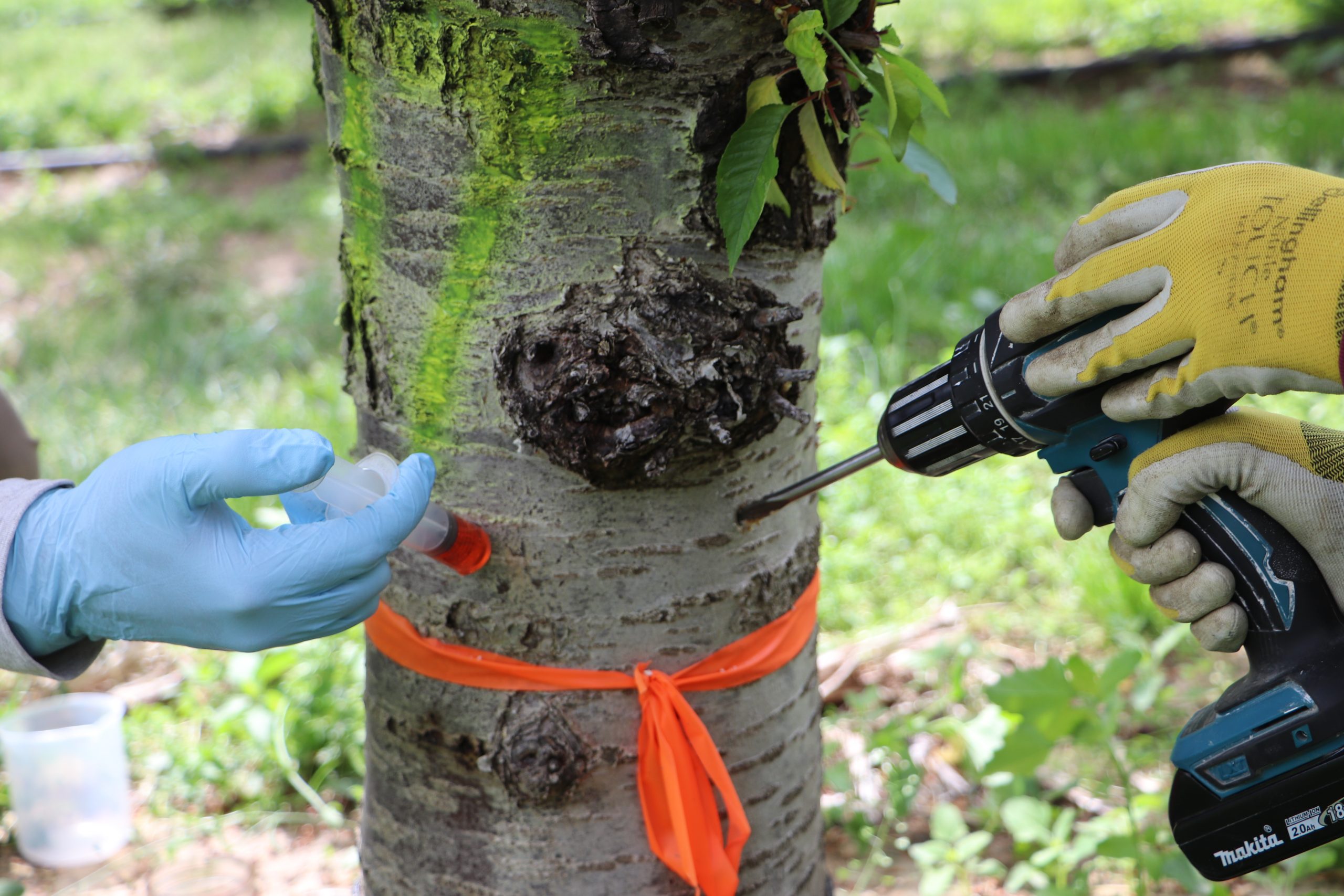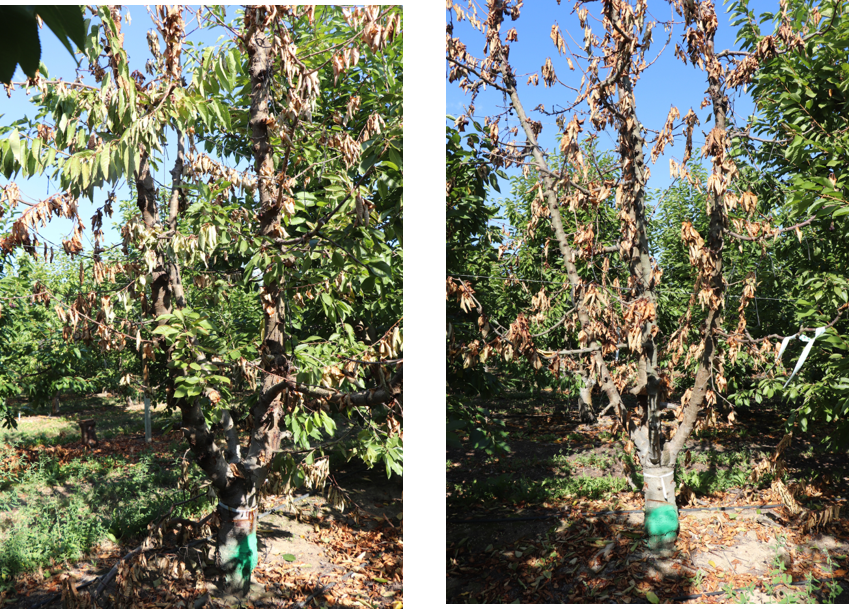By Tianna DuPont, Chris Strohm, Cody Molnar, Ricardo Naranjo, WSU Extension; Garret Bishop, GS Long. August 8, 2020
August and early September are good times to remove trees infected with X-disease phytoplasma and Little cherry virus. Quick removal reduces the time infected trees are providing a source of the pathogen for insects to move around. Late summer/ early fall applications of herbicides are likely readily translocated to roots and can identify root grafted adjoining trees.
General recommendations for tree removal include: 1) apply insecticide before tree removal to limit spread; 2) remove infected trees; 3) apply glyphosate to cut stump or frill to identify root grafted trees and kill roots or remove as many roots as possible and test adjoining trees; 4) if more than 20% of block is infected consider whole block removal. Timely removal of infected trees which are the source of spread is most important.
Below are the first three of six case studies on tree removal.
Mattawa case study
Dale Goldy is removing a block of Bing on Mazzard and a Block of Bing on Giesla 6 in the Mattawa area. They have tried herbicide application with the speed sprayer for removal of an entire block and felt it was not effective in killing the whole tree. This year, for 32-42 inch circumference trees (13 inch diameter) they are drilling 4 to 5 holes per tree about 4 ½” deep and 1/2” diameter at a 45 degree angle down and applying a 100% glyphosate concentration to fill holes with a handheld sprayer. They are keeping the block soil moisture at about 60% field capacity to make sure there is enough moisture for trees to move the glyphosate through the plant. Dale feels it is important to remove trees quickly so leafhoppers are not moving the phytoplasma around and he has time this fall to fumigate once the soil cools down. Three weeks after application all trees had significant herbicide injury with about 90% showing symptoms in all leaders. Root suckers also showed herbicide injury a good sign that roots were affected. Root death rating of 40 trees showed 88% root death.

Orondo Case Study
In mid May 2019 we trialed two treatments for tree removal at a block in Orondo of Rainier cherries on Mazzard where trees had tested positive for X-disease phytoplasma last fall. Treatments applied to 35 trees included a 50:50 glyphosate and water concentration – 2”deep holes every 4” with 4ml/hole dilute (3/8”diameter hole) and 100% glyphosate concentration 1”deep holes every 4”with 2 ml/hole concentrate (3/8”diameter hole). Two weeks after herbicide application all trees had 50-80% damage with severe yellowing to browning and death from herbicide treatments. None of the adjoining trees had noticeable herbicide injury. After 4 weeks only 5 adjoining trees showed herbicide injury. Injury was slight. Rating of root death five months after herbicide application showed 95-100% root death.

Yakima Case Study
On July 23, 2019 a trial was conducted in Bing on Gisela 12 with five herbicide treatments for tree removal. Two treatments of interest were a 100% glyphosate concentration applied with a paintbrush to the cut stump at the interface of the bark with the wood/cambium and a notch treatment where 4 notches with 5 ml per notch of 50% glyphosate were applied. Four weeks after herbicide application trees in the notching treatment were showing severe herbicide injury (death) in the above-ground portion of the tree (see figure 2). Four weeks after herbicide application only three adjoining trees showed minor herbicide injury to 1 or 2 limbs. At tree removal the spring after herbicides were applied root evaluation found the majority of roots were still living. The notch + glyphosate treatment had significantly larger numbers of injured and dead roots. However, no treatments had near 100% root death. The notch + glyphosate treatment performed best.

Figure 4. Trees in notch + glyphosate injection treatment 4 weeks after herbicide application.
Additional Information
BMPs for tree removal for X disease and Little Cherry Virus infected trees https://treefruit.wsu.edu/article/bmps-for-tree-removal-for-x-disease-and-little-cherry-virus-infected-trees/
https://treefruit.wsu.edu/crop-protection/disease-management/western-x/
Contacts
Tianna DuPont, WSU Extension (509) 293-8758 tianna.dupont@wsu.edu
Bernardita Sallato, WSU Extension (509) 439-8542 b.sallato@wsu.edu
Ashley Thomson, OSU Extension (541) 296-5494 Ashley.Thompson@oregonstate.edu
Karen Lewis, WSU Extension (509) 760-2263 kmlewis@wsu.edu
Use pesticides with care. Apply them only to plants, animals, or sites listed on the labels. When mixing and applying pesticides, follow all label precautions to protect yourself and others around you. It is a violation of the law to disregard label directions. If pesticides are spilled on skin or clothing, remove clothing and wash skin thoroughly. Store pesticides in their original containers and keep them out of the reach of children, pets, and livestock.
YOU ARE REQUIRED BY LAW TO FOLLOW THE LABEL. It is a legal document. Always read the label before using any pesticide. You, the grower, are responsible for safe pesticide use. Trade (brand) names are provided for your reference only. No discrimination is intended, and other pesticides with the same active ingredient may be suitable. No endorsement is implied.
treefruit.wsu.edu articles may only be republished with prior author permission © Washington State University. Republished articles with permission must include: “Originally published by Washington State Tree Fruit Extension at treefruit.wsu.edu” along with author(s) name, and a link to the original article.

